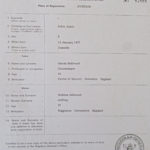The Oamaru anchored off the entrance to Otago harbour on the morning of 16 December 1876 after a relatively smooth run of 83 days. The paddle-steamer tug Geelong guided the Oamaru through the Otago heads. The ship’s health situation was assessed and, with the yellow flag hoisted, she was quarantined.

The following day, Sunday 17 December, the sick, the married and the single females were transferred to Quarantine Island by way of the Customs launch and two of the Oamaru’s lifeboats. The single men were transferred to neighbouring Goat Island the following day.
The situation on arrival and the first few days on Quarantine Island are best summarized by Jane Findlayson in her trip diary:
Saturday 16 December: Thank God we are safely anchored in Port Chalmers but the yellow flag has been hoisted and we are doomed to be quarantined for a week at least. We stay on the ship all day and tomorrow we go on an island for the purpose where we will have every convenience for getting our things all washed. The married folks are on one end of it and we are on another end; and what is laughable is the young men are put on an island [Goat Island] opposite us with the water between. We enjoy the sight of New Zealand very much and see it’s quite true what Christie said about being a very hilly country. Mr Bannerman told us to get a letter ready if we wanted to send one to any of our friends and he would take them. Agnes wrote one to her brother and I to Invercargill telling them not to expect us for a week or more. I hope we will be there before Christmas. We are in expectations of getting a walk on “terra firma” tomorrow.
Sunday 17 December: This is Sunday and it is not at all like it. A great bustle and everyone is getting their beds and tins packed up for landing at Quarantine Island. The married men and single girls went off. We got landed about 2 o’clock and found a very pretty with everything clean and comfortable. It’s a large house nicely built and to all appearances like a hydropathic establishment. The rules are much the same; if you don’t appear at meal times you get none. There is a large dining room and we sleep in small apartments for eight. We like to take a walk among the bushes.
Monday 18 December: This is a beautiful morning. We have to be up by seven and have our places cleaned before breakfast. We also had a good walk and really it is fine scenery. So many rocks and trees and nice houses along the seaside. Father would enjoy to have a bit of property here; far better than at Dunoon and Kirn. I never saw any place so nice. We will wash tomorrow and get everything cleaned before we go ashore. We get letters to and from here every day so I have wrote to one or two in Dunedin and will get word back to keep me a little cherry. We expect to get ashore this week and hope it is true, for I would not like to spend Christmas here. We have heard that the voyage of our ship is in the newspaper of today so will try and get one sent home.
In his medical report on the journey, ship’s doctor Dr Hasard reported there were 31 cases of measles and two cases of enteric (typhoid) fever amongst the passengers. Four deaths occurred – two from measles, one from diarrhea, and one from infantile exhaustion. The single men on Goat Island were “admitted to pratique” (port quarantine clearance) on 22 December, after five days in quarantine. Those who were married without children, and those with children that previously had measles, were cleared on 28 December. Single women were cleared of quarantine on 2 January 1877. Jane Findlayson, despite her hopes, spent 16 days, over Christmas and New Year, on Quarantine Island.
So what happened to the Selwood family on arrival? According to grandchild, Irene Calder, daughter of Helena Emma (Nellie) Selwood, she understood that her grandfather James was very ill on arrival and was kept in quarantine. However, by Friday 5 January, some 100 family immigrants, all except one couple (not the Selwoods) were discharged from quarantine, given the freedom of the colony, and were transferred to Port Chalmers by way of the steamer Iron Age. They then travelled by local train to Dunedin and to the Caversham Barracks until onward travel was finalised. The Port Chalmers to Dunedin line was the first narrow-gauge railway line in New Zealand, which became the standard for the New Zealand rail network. It opened in January 1873, just four years before the Selwood family travelled on it.
It is likely that Robert Campbell or one of his agents (A.C Begg?) met the Selwoods on arrival in Port Chalmers or Dunedin and gave them guidance. There were other Oamaru passengers, mainly Scottish masons, bound for the Campbell property at Otekaikie to build their planned 35-room baronial mansion.
For Helena and James, their Dunedin stay was a little longer than most, because on 14 January 1877 Helena gave birth to her second born! Their first girl, Edith Annie Sellwood (two “l’s), was born in Dunedin. What a woman of stamina! After a three-month sea journey without a break, while in her sixth, seventh and eight months of pregnancy, surrounded by immigrants taken low with measles and other ailments, transferred into island quarantine for two weeks, and then just ten days later she gives birth to her second baby! This stamina and strength was regularly displayed through her life.
Quarantine and Goat Islands are in Otago harbour midway between the harbor entrance and Dunedin. Quarantine Island, Maori name Kamau Taurua, was first used for quarantine purposes in 1863, and reached its peak quarantine use in the 1870s and 1880s. The island is now a scenic reserve and some of the original buildings remain. Goat Island, or Rakiriri, is only 200 meters north-west of Quarantine Island and separated by the beginnings of the dredged Victoria Channel which enables shipping up the harbour to Ravensbourne and Dunedin. Goat Island served as a quarantine overflow with a two-story barrack similar to the one on Quarantine Island. Goat Island is now uninhabited and is a nature reserve.
When they arrived in Dunedin in January 1877, the Selwood family would have found a big bustling city. It was New Zealand’s first city, established in 1865, with a population boosted by the Otago gold rushes of the 1860s, and at that time was New Zealand’s largest and wealthiest city. Dunedin was the home of the first New Zealand university, the University of Otago, established 1869. Dunedin is known as the Edinburgh of the south and, in its buildings, streets, and culture, retains a strong Scottish influence.
The Caversham Barracks were built in the early 1870s to cater for the increased number of immigrants arriving under the Julius Vogel settlement scheme. The building was able to accommodate 400 people with families, single men and single women separated. The Selwoods probably stayed there prior to and after the birth of Edith. From Dunedin the Selwoods moved to their new home on the Campbell station at Burwood, near Mossburn in northern Southland. How they got there is uncertain. In early 1877 the railway went only part way to Invercargill. So perhaps they went by train, coach and then by bullock train to reach their new home, but of greater possibility is that they went by boat, the Express, from Port Chalmers to Bluff, and then by train from Bluff to Invercargill and further north to Lumsden on the newly opened rail line, then by horse and/or bullock-drawn coach.













